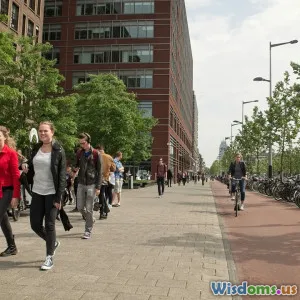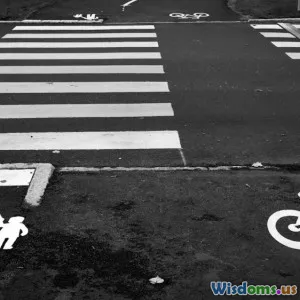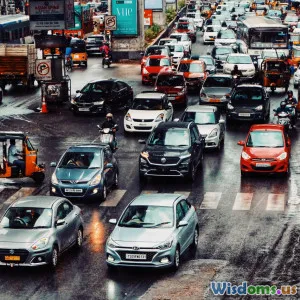
Could Your Daily Commute Be Greener Switching to Pedestrian Routes
14 min read Discover how switching to pedestrian routes can make your daily commute greener and more sustainable. (0 Reviews)
Could Your Daily Commute Be Greener? Switching to Pedestrian Routes
Imagine catching the first morning breeze as you make your way to work, passing by familiar shop windows and gardens, instead of idling in traffic fumes. With increasing concerns over climate change, urban congestion, and personal well-being, transforming your daily commute by taking pedestrian routes is not just a sustainable choice—it’s a statement. Today, many commuters are questioning whether a greener, healthier change could be as simple as lacing up their walking shoes rather than turning a car key.
Walking might seem like a small change, but its ripples can become significant both for individuals and entire communities. Let’s explore why embracing pedestrian commuting isn’t just possible—it’s powerful.
The Environmental Impact of Commutes

Our daily transportation choices have an outsized effect on the planet. In 2021, the transportation sector accounted for approximately 27% of total greenhouse gas emissions in the United States, with the majority stemming from passenger vehicles. These daily trips, often less than five miles—very walkable distances—add over 1 billion metric tons of CO₂ annually worldwide.
Let’s put this into context:
- A five-mile round trip in an average car emits roughly 2 kilograms of CO₂.
- A commuter walking instead slashes that personal carbon output to nearly zero.
Even if you occasionally switch to walking for just two days a week, it's equivalent to planting more than a dozen trees each year. Moreover, vehicles congest city centers, creating smog and noise pollution, while harming air quality—a direct link to respiratory ailments and reduced quality of life.
Case Study: In Paris, France, aggressive pedestrianization policies have led to cleaner air and more vibrant street life, serving as a blueprint for cities worldwide.
Comparing the Commute: Pedestrian vs. Driving

On the surface, driving may seem more convenient and time-saving than walking. But a deeper comparison reveals many hidden costs (and benefits) for each approach.
| Metric | Driving | Walking |
|---|---|---|
| CO₂ Emissions | 271g/km (avg sedan) | Negligible |
| Fuel/Energy Cost | $0.12/mile (avg) | Practically $0 |
| Parking Hassles | Frequent | None |
| Health Benefits | Minimal | High |
| Stress Level | High (traffic, noise) | Lower (fresh air) |
Fact: A 2019 survey from the UK’s Department for Transport showed that, in congested urban areas, walking two miles often takes just 5-10 minutes longer than driving—without the added parking hunt and gridlock.
Example: Consider Lisa, an urban dweller with a 1.5-mile commute. She switched to walking three times a week. Beyond burning about 90 calories per walk, Lisa noticed more reliable commute times (she's not at the mercy of traffic) and even spends more time listening to audiobooks on her strolls.
Health Benefits that Last a Lifetime

The World Health Organization recommends at least 150 minutes of moderate aerobic physical activity weekly. For many—particularly office workers—finding extra time to exercise is challenging.
Incorporating walking commutes embeds physical activity seamlessly into daily life, providing immense benefits:
- Cardiovascular Improvement: Regular walking lowers the risk of heart disease and high blood pressure.
- Mental Health Boost: Studies show commuters who walk experience lower rates of stress, depression, and anxiety. Nature exposure and rhythmic movement activate relaxation responses in the brain.
- Weight Management: Walking just 2 miles per workday burns about 500 extra calories a week—potentially several pounds per year.
- Reduced Sick Days: Employees who walk to work report fewer illnesses and higher productivity.
Expert Insight: Dr. Wendy Suzuki, neuroscientist and author, explains, “Even a 20-minute daily walk greatly enhances memory, creative thinking, and mood.”
Financial Upside: Saving More Than Just Gas

Switching from a car-centric routine to a pedestrian one delivers surprising financial benefits. The average American household spends nearly 16% of its income on transportation costs, often second only to housing. Here’s how walking slashes expenses:
- No fuel or fares: A 2-mile daily walking round trip saves approximately $130 a year in fuel alone.
- Lower maintenance: Less driving means fewer oil changes, repairs, and tire replacements.
- Reduced insurance premiums: Less time spent driving can result in lower car insurance rates.
- Parking fees eliminated: Urban parking can cost $8-25 per day—a significant, often hidden, workplace expense.
Real-World Example: In Portland, Oregon, commuter Jonathan realized savings topping $1,000 in a year simply by downsizing to occasional car use and opting for walking plus public transit.
Overcoming Obstacles: Making Pedestrian Commutes Feasible

Choosing to walk daily isn’t without challenges—distance, safety, and community design matter. Fortunately, with thoughtful planning and a proactive approach, many can overcome these barriers:
Shortening the Distance
- Multimodal commutes: Combine walking with public transit or cycling for longer trips.
- Remote work flexibility: With hybrid jobs booming post-2020, plan fewer, more active commutes.
Addressing Safety Concerns
- Use well-lit and busy routes recommended by local authorities.
- Advocate for improvements: Get involved in local campaigns for better sidewalks, crosswalks, and traffic calming measures.
- Buddy up: Walking with a colleague or neighbor enhances safety, motivation, and social connections.
Comfort and Preparation
- Pack appropriate gear: Weather-resistant footwear, umbrellas, and quick-dry clothing make walking viable year-round.
- Leverage technology: Navigation and safety apps (like Citymapper, SafeWalk, or local transit trackers) can make commutes smoother and safer.
Tip: Try a “walk audit” of your route. Many cities offer online tools (such as Walk Score or AllTrails) to evaluate pedestrian-friendliness and suggest improvements.
Urban Design: The Rise of Walkable Cities

Globally, cities are transforming car-centric roads into walkable, human-friendly spaces:
- Barcelona’s Superblocks: Certain neighborhoods restrict through-traffic on multiple city blocks, giving streets back to pedestrians and cyclists.
- New York City’s Times Square: Closing sections to vehicles revitalized the area, lowering pollution and boosting local business revenues by over 25%.
- Melbourne, Australia: The “20-minute neighborhood” planning concept places most daily needs within a short walk.
These initiatives prove that walkability can revolutionize transit patterns, community vibrancy, and even local economies.
Fact: A Harvard School of Public Health study found residents in walkable neighborhoods have lower rates of obesity and chronic disease.
Actionable Steps: Greening Your Commute Today
Ready to make your own impact, one step at a time? Here’s how to get started:
- Assess your commute distance. Map the walking route using digital tools. If your commute is within 2-3 miles, it’s typically walkable in under 40 minutes.
- Set achievable goals. If a full walk isn’t realistic daily, start with once weekly or walk part-way combined with public transport.
- Prepare your walking toolkit: Comfortable shoes, a water bottle, headphones or a favorite podcast, and a weatherproof jacket can make the routine enjoyable.
- Buddy up and share your progress. Encourage colleagues or family to join. Social accountability boosts consistency.
- Advocate and participate. Support local initiatives for improved pedestrian infrastructure—your voice helps transform cities for everyone.
- Track and celebrate change. Apps and fitness trackers turn daily steps into rewarding milestones (and may be incentivized by some employers).
Pro Tip: Consider “commute walking meetings” if your job allows. Walking while discussing ideas is shown to enhance creativity and teamwork.
The Ripple Effect: When Individuals Lead, Communities Follow

The choice to transition even one drive a week to walking catalyzes change beyond personal benefit:
- Reduced congestion for all commuters; every avoided car trip means a smoother road for everyone else.
- Enhanced local economies: Walkers support neighborhood shops, cafes, and services more often than drivers.
- Safer, livelier streets: Pedestrian activity encourages better lighting, upkeep, and neighborhood pride.
- Intergenerational impact: Young people walking to school or older adults keeping active enjoy lasting health and community ties.
Consider London’s yearly “Walk to Work Week,” when tens of thousands participate, resulting in significant city-wide decreases in vehicle use and boosts to local commerce.
A greener commute is possible—and powerful—when you blaze a new, pedestrian-first path. Swapping even a portion of your daily drive for walking leaves a lasting mark on your health, finances, and the planet. Whether you're taking your first steps or joining a citywide movement, remember: your commute is more than just a journey; it’s your chance to walk the change you want to see.
Rate the Post
User Reviews
Popular Posts


















